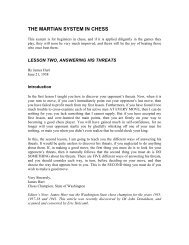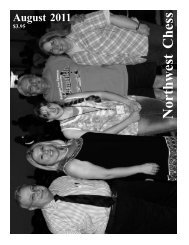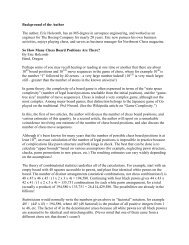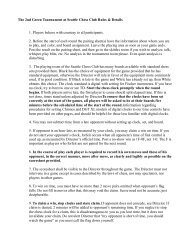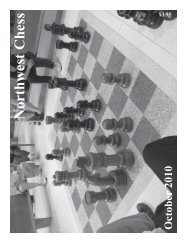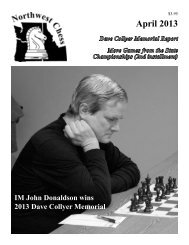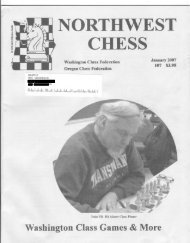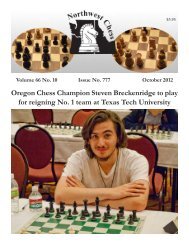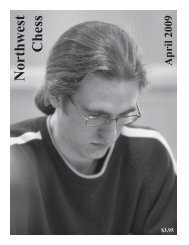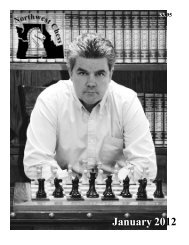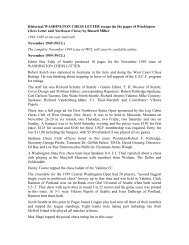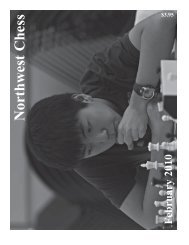Create successful ePaper yourself
Turn your PDF publications into a flip-book with our unique Google optimized e-Paper software.
after 16. fxe4, he has to do something about<br />
the fork, and somehow not get overrun in<br />
the center and on the kingside. That looks<br />
like a major challenge.<br />
Master: A challenge? To be<br />
sure...Actually, it might be impossible. The<br />
game Leander-Kossin (ICCF 1990)<br />
continued 13. ...h6? 14. Bxf6 Qxf6 15. e4<br />
dxe4 16. fxe4 Qg5 17. e5 Bc7 18. Ne4 Qe7<br />
19. Nf6+! and Black was quickly crushed.<br />
Ulf Andersson at Belfort in 1988, which<br />
Garry won convincingly. Now the bishops<br />
were traded with 15. Bxe7 Rxe7, and once<br />
again Botvinnik holds back his central<br />
advance. Kasparov evaluates Black’s<br />
position after 16. e4 dxe4 17. fxe4 Ndf8 as<br />
being slightly inferior, but “perfectly<br />
defensible.” Instead, Botvinnik plays 16.<br />
Ng3, and after 16. ...Nf6, further supports<br />
his center with 17. Qf2. Keres now played<br />
17. ...Be6, reaching this position. What do<br />
you think? Is it time?<br />
Now it’s Keres’ turn to figure out how<br />
to deal with the changed realities. He chose<br />
to exchange the bishops with 14. ...Nd7,<br />
avoiding the complications arising from 14.<br />
...h6 15. Bxh6 gxh6 16. Bxg6 fxg6 17.<br />
Qxg6+ Kh8 18. Nf4 Bf8 19. Qf7 Bf5.<br />
So Black has to be really careful here.<br />
Keres clearly realized he’d made a mistake,<br />
and like most very strong players in such<br />
situations, he doesn’t ignore necessity. He<br />
simply retreats with 13. ...Be7. What now?<br />
Student: Well, e4 was the point, wasn’t<br />
it? (He plays 14. e4 and the Master replies<br />
14. ...dxe4, and after 15. fxe4, plays 15.<br />
...Ng4.) Hmm...you’ve got real counterplay,<br />
don’t you? Was my 14. e4 premature?<br />
Master: Uh huh. Actually, White needs<br />
to be quite careful about his timing. One of<br />
the most instructive things about this game<br />
is the way Botvinnik patiently holds back<br />
the e4 break until he has placed his pieces<br />
as optimally as possible.<br />
Student: I guess that make sense. After<br />
all, Black can’t really stop e4, can he?<br />
Master: Not easily. Now that the map<br />
has changed, Botvinnik starts repositioning<br />
his pieces. No minority attack today! The<br />
future is in the center, and so he centralizes<br />
his rook with 14. Rbe1. Notice that<br />
Botvinnik doesn’t try to “justify” the<br />
position of his rook on b1. It went there to<br />
support the queenside attack. The map has<br />
changed enough that another fundamental<br />
strategy—central advance—is now in play,<br />
and so Botvinnik adjusts his pieces<br />
accordingly.<br />
However, Botvinnik suggests Keres was<br />
perhaps wrong to do so. This may be Black’s<br />
best chance. In fact, “Little Miss Monster”<br />
thinks the chances are about level after 19.<br />
...Bf5.<br />
Student: Little Miss Monster? As in<br />
“Little Miss Silicon Monster?” (Thinks for<br />
a second and chuckles) Oh, I get it—Rybka<br />
means “little fish” in Czech and Polish,<br />
doesn’t it? And Vasik Rajlich—Rybka’s<br />
programmer—always refers to the program<br />
as female. Cute.<br />
Master: A little light relief...Another<br />
possibility is 14. ...c5. What do you think?<br />
Student: Don’t like it much...after 15.<br />
dxc5 Bxc5 16. Bxf6 gxf6 and 17. Nd4,<br />
Black’s pawn structure is shattered. That’s<br />
likely to be a nightmare against any strong<br />
Grandmaster, never mind Botvinnik. After<br />
14. ...Be6, does White play 15. e4<br />
immediately?<br />
Master: Probably. Kasparov notes the<br />
play is likely to be similar to his game against<br />
Student: Let’s see: if White plays 18.<br />
e4, Black responds 18. ...dxe4 19. fxe4, and<br />
then presses the White center with 19.<br />
...Rd7. White probably has to defend with<br />
20. Nge2, and then it’s not so clear how he<br />
goes forward. It looks like he has the<br />
advantage, but I also don’t see how he does<br />
much with it. So maybe White waits a bit<br />
longer. Can he further improve his knight?<br />
Master: Smack on! Instead of rushing<br />
forward, Botvinnik played 18. Nf5, and we<br />
reach another critical juncture in the game.<br />
What do you think Black should do here?<br />
Student: Well, that knight looks pretty<br />
dangerous, but I’m not crazy about 18.<br />
...Bxf5 19. Bxf5, either. I’m not sure,<br />
perhaps Black should simply retreat with 18.<br />
...Re8, or maybe consider 18. ...Rd7 with<br />
the hope of creating pressure against the<br />
center.<br />
Master: Interestingly, the two major<br />
commentators on this game—teacher and<br />
student: Botvinnik and Kasparov—seem to<br />
disagree at this point. Botvinnik writes: “If<br />
18. ...Re8 then there would have followed<br />
19. g4 and then after the exchange on f5<br />
White would have recaptured with the g-<br />
pawn, causing Black fresh problems.” One<br />
has the impression that Botvinnik assumed<br />
the exchange on f5 was ultimately<br />
Page 18 <strong>Northwest</strong> <strong>Chess</strong> August 2009



